Ossoff DEFEATED! Ossoff VICTORIOUS!: An Email Cautionary Tale
Published on November 15, 2017/Last edited on November 15, 2017/11 min read


Todd Grennan
Content Production Principal, Content Marketing at BrazeBad political outreach knows no partisan divide.
During the 2016 U.S. presidential election, we saw a lot of poorly-conceived, ethically questionable email marketing from the Republican nominee and a sizeable amount of repetitive batch-and-blast emails from his Democratic opponent (though her mobile engagement strategy was on point.) But while the 2016 presidential election came and went, political candidates’ struggles with their digital outreach have continued, spilling over into a number of high-profile special elections during the first half of this year.
Political candidates and organizations have different marketing goals than brands and the rules they have to follow when it comes to outreach are different (in part because politicians have exempted themselves from anti-spam laws that apply to everybody else). But they’re still trying to use technology to raise money and build relationships with their target audience. And that means that there’s a lot that marketing, growth, and engagement teams can learn from political messaging, even—or maybe especially—when it goes seriously awry.
Email marketing campaigns, the DCCC Way
Picture this: it’s Thursday, May 25, 2017, and you’re a left-leaning individual living somewhere in the United States. You donate monthly to the Democratic Congressional Campaign Committee (DCCC) and a few weeks back gave $10 to the campaign of Rob Quist, the Democrat candidate running in a special election in Montana. And when your alarm goes off at 8:00 a.m., you brush the sleep from your eyes, make some coffee, and check your email. And find yourself greeted by an email from the Quist campaign:
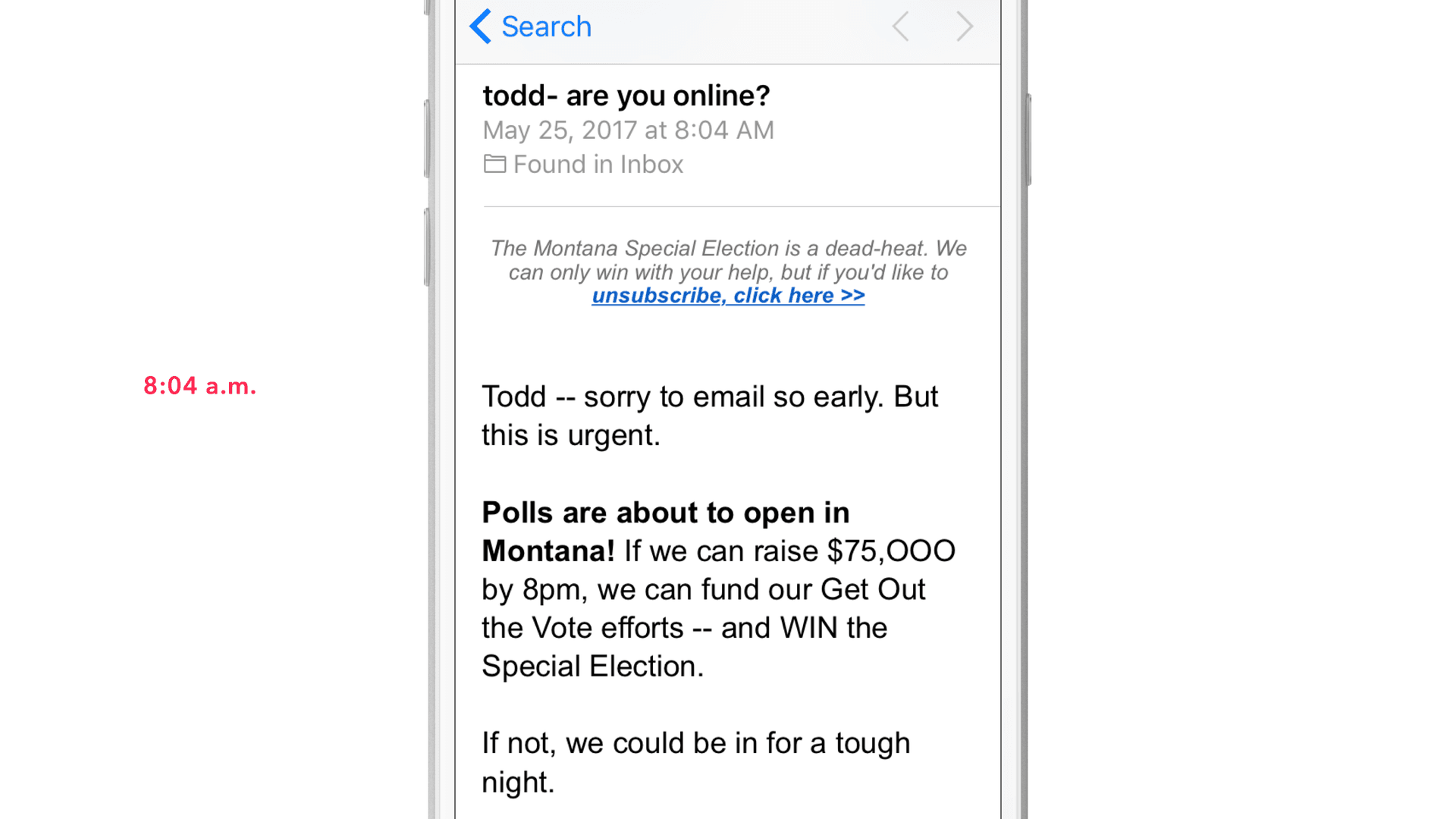
You open the email, and find a solicitation for more donations from the Quist campaign. Consider for a moment. Then decide against giving more money right now. You go about your day, head to work. A couple hours pass. Another email from the Quist campaign appears in your inbox. And another. And another. Before you go to bed, you’ve received nine emails from them asking for money, each with a click-baity, vaguely hysterical, seemingly-randomly-capitalized subject line:
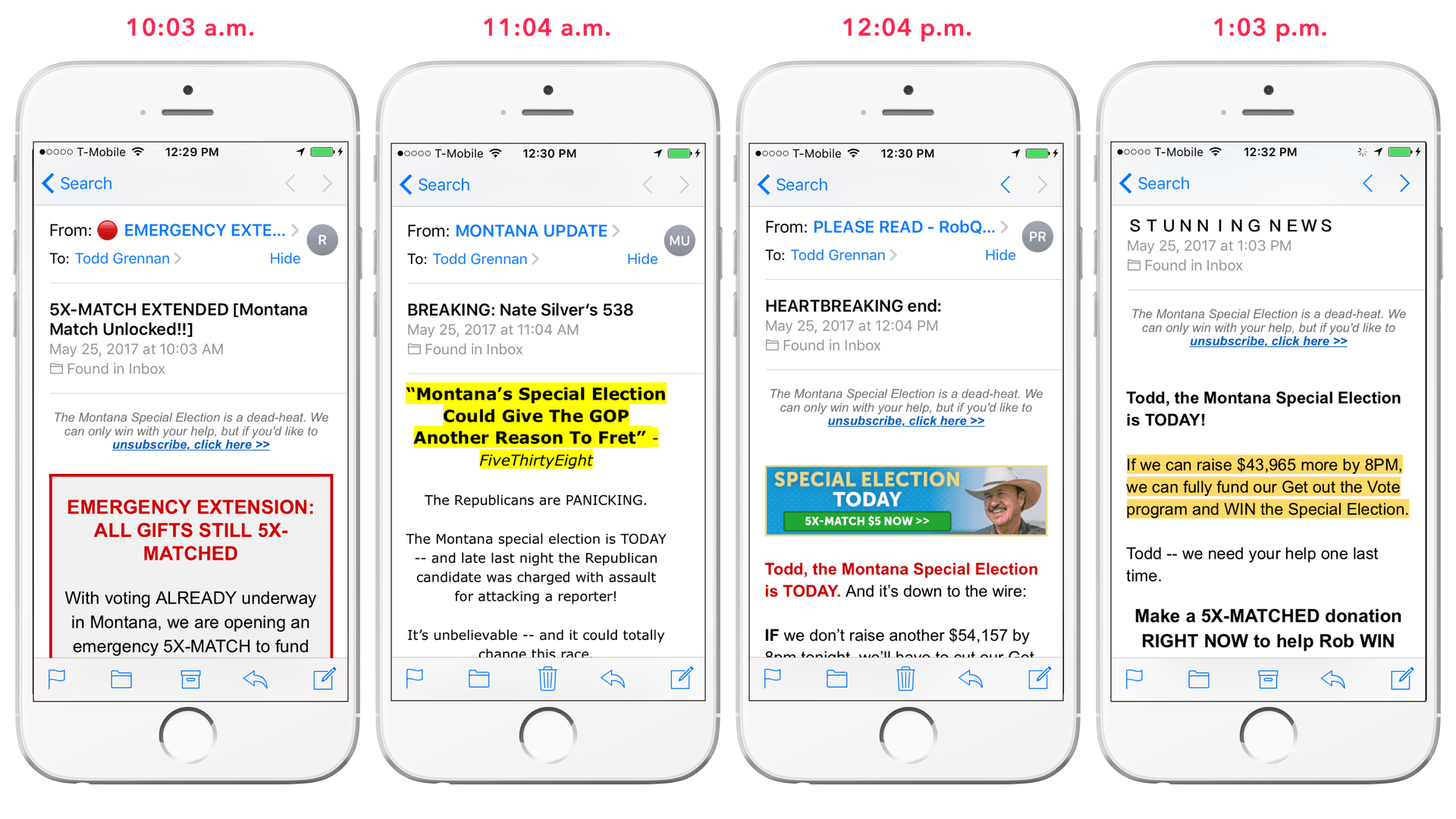
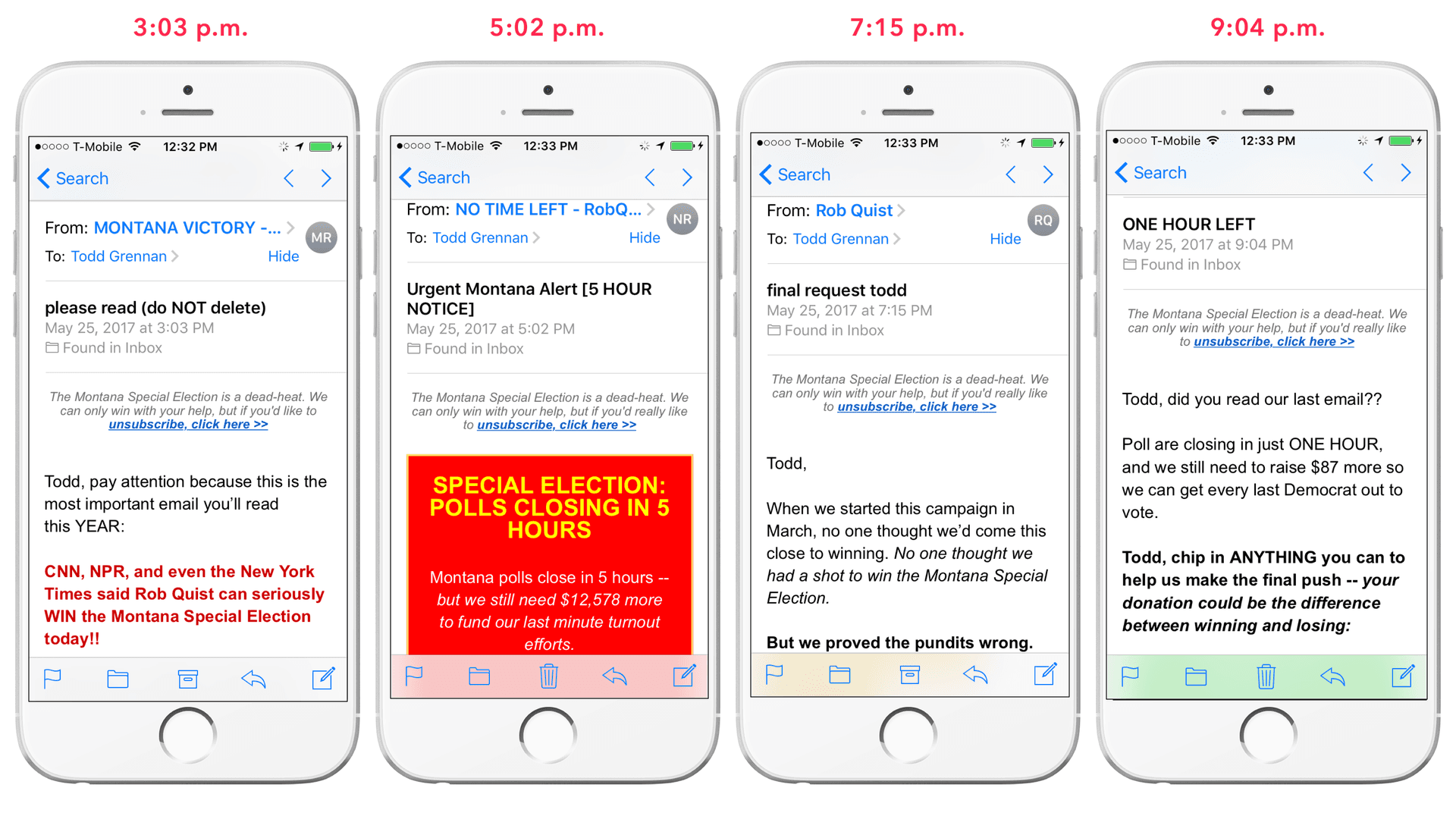
Quist loses. But you keep getting emails like these by the dozen. From the DCCC. From other Democratic special election candidates, like Georgia’s Jon Ossoff. All of them begging for money. Their subject lines and body text swinging from champagne-popping declarations of certain victory to apocalyptic gloom. You unsubscribe from one email address, then another. But the messages keep coming, from the DCCC and from putatively independent groups with names like End Citizens United and The Progressive Turnout Project.
What’s going on? You’re a good person—why is this happening to you?
The short version: it’s the DCCC’s fault. Back during the 2014 election cycle, in an effort to juice the Democratic Party’s takings from small donors during an election that, to put it lightly, didn’t favor their party, the DCCC pioneered a new approach to political email marketing campaigns. Incessant messages asking for donations. Wild shifts in tone from email to email. Highly questionable claims about funding deadlines and double or triple or quadruple donation matches.
The strategy brought in enormous quantities of money for the DCCC and its candidates, allowing the Democratic Party to out-raise Republicans by more than 30%. However, that extra cash did little to boost Democratic candidates, and the emails themselves triggered widespread backlash, inspiring both a parody Tumblr account and a mocking song where all the lyrics were taken from DCCC subject lines.
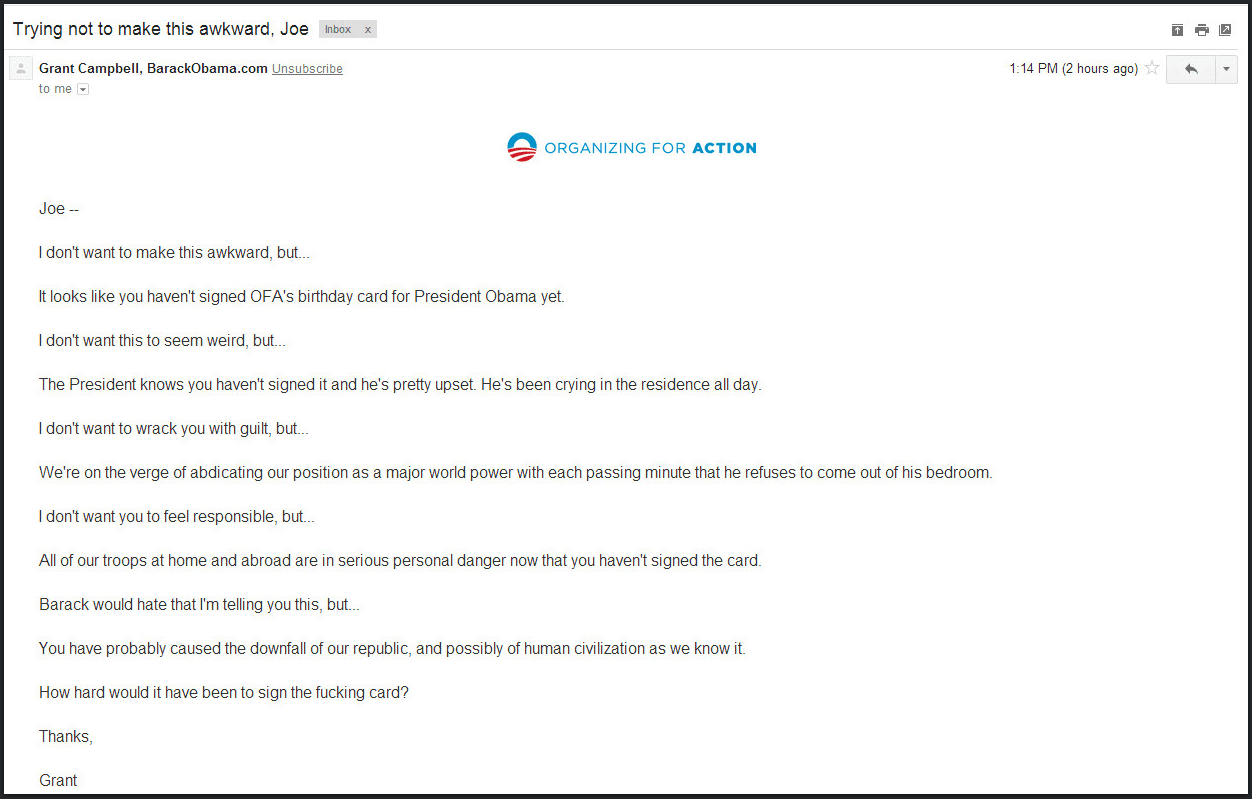
An entry from 2014’s “Emails from the DCCC” parody Tumblr
Following the election, the DCCC doubled down on its strategy. Then a group of DCCC veterans went off on their own, founding a left-leaning digital consulting firm known as Mothership Strategies that took the DCCC approach to email marketing and brought it to individual Democratic campaigns, including Ossoff and Quist’s election efforts. Between DCCC and Mothership, Democratic-leaning donors have found themselves inundated with alarmist, frustrating emails.
Selling out tomorrow: Why bad email marketing campaigns matter—even for political campaigns
Why do Democratic candidates and organizations keep inundating their donors with aggressive, irritating emails? Because they think it’s a successful strategy. Back in 2014, then-head of the DCCC Rep. Steve Israel told reporters, “I apologize all over the country for the volume of email people get, but it works,” and argued that the strategy had “revolutionized online fundraising.”
But while this kind of churn and burn approach to email can pay off in the short-term when it comes to juicing your fundraising, there’s a long-term cost. The DCCC email strategy—which Michael Whitney, the former digital fundraiser for Democratic presidential candidate Bernie Sanders, describes as a “wildly deceptive, unrelenting approach that treats supporters like garbage”—is pretty much the real-life, political version of Appboy Siege: it’s deeply unpleasant for recipients and can make the candidates in question look desperate and panicky. And there’s reason to think it’s poisoning the well for future Democratic candidates and potentially driving down real voter engagement, which ultimately determines the success or failure of any political campaign.
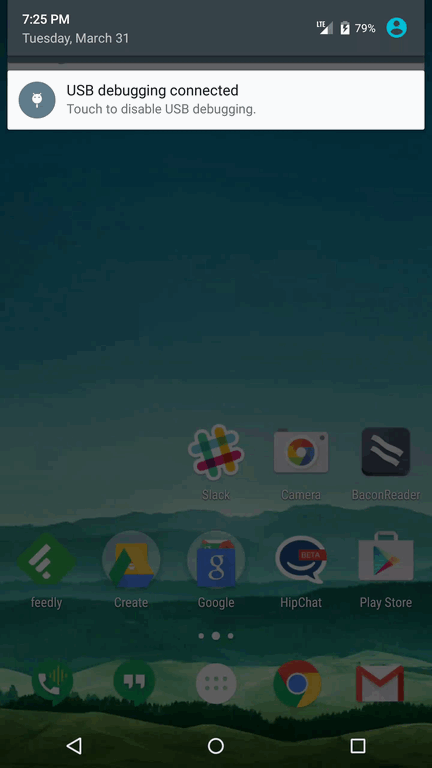
It’s kind of like this… but for political donations
With the help of Mothership Strategies, Rob Quist raised more than $6 million—and lost. Jon Ossoff’s donations exceeded $23 million, but they didn’t put him over the top. Arguably the only real winner on the Democratic side of these races was Mothership, which pocketed more than $4.2 million in fees for its efforts. And Ossoff and Quist may not be the only losers over the long haul: a 2014 study found that individuals exposed to DCCC emails subsequently made donations to left-leaning groups that were 15% lower than those who didn’t receive the messages, suggesting that these tactics could drive down fundraising over time.
What it means for brands: 5 email marketing campaign missteps to learn from
The upside of all this? While the DCCC and Mothership have made a lot of questionable decisions when it comes to sending email outreach to their audiences, that means that marketers have have a chance to learn from them without having to make the same mistakes themselves. That’s a big opportunity.
Okay. So what does the DCCC approach to email get wrong?
1. Sending way, way too many messages (and sending them too frequently)
Look, nobody wants to receive nine emails asking them for money in a thirteen hour period. And they certainly don’t want to get anything approaching that volume of email day after day after day. That’s exhausting, and significantly increases the chances that recipients unsubscribe or start tuning out your messaging.
Instead of sending a bunch of similar emails, send one email and use multivariate testing to optimize it. You’ll send the best possible message to your audience, and that’ll do more to drive donations (or whatever conversion you’re aiming to encourage) than a barrage of semi-relevant outreach.
2. Sending outreach in only one messaging channel
Email is great. It’s one of the best messaging channels for return on investment (ROI), and, for a lot of customers, it’s their prefered way to hear from brands. But it doesn’t exist in a vacuum. Some of your most valuable customers may not be interested in joining your email list, and others will tire of receiving email after email and unsubscribe. If you only use one channel to communicate with your audience, that unsubscribe is the end of the story.
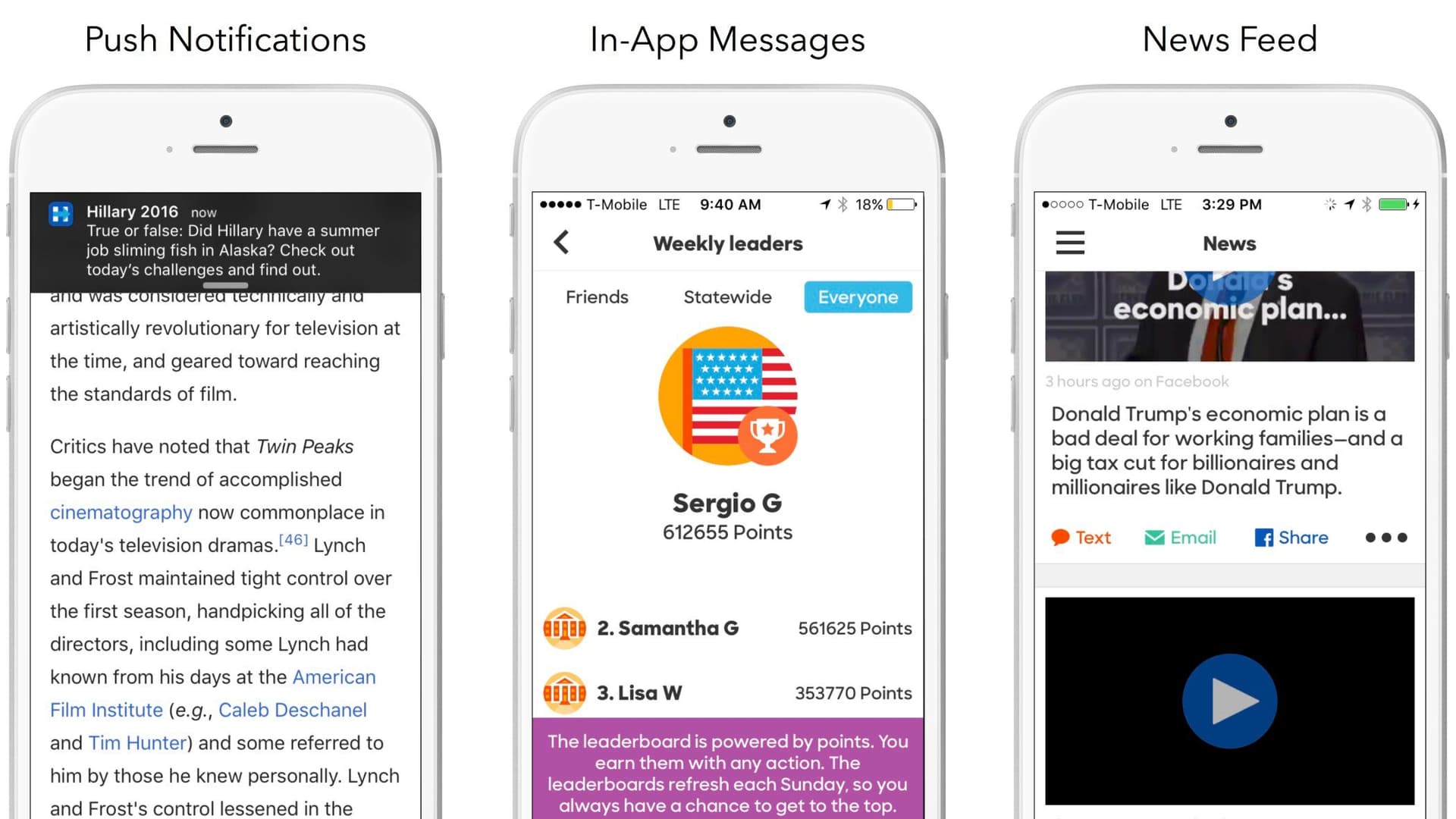
Hillary Clinton’s 2016 campaign app leveraged multiple channels to great effect
Hillary Clinton’s presidential campaign aside, most political campaigns don’t have a native app. That means that push notifications and in-app messages are off the table for them (though there’s no reason marketers shouldn’t take advantage of them). But robust cross-channel outreach is still possible even without an app. Thanks to web messaging, it’s now possible to use email, web push, in-browser messages, and web News Feed Cards in concert to engage your audience on desktop and the mobile web. And this kind of cross-channel approach can pay big dividends: onboarding campaigns sent using multiple channels see nearly 85% higher 60-day customer retention than those delivered in a single channel.
3. Sending only one kind of email
Email is more than just a way to nudge people to give you money. It’s a powerful, highly flexible outreach channel, and it’s just as good at keeping people informed and building relationships with your audience as it is for encourage one more donation.
There’s nothing wrong with asking for donations; just like businesses need revenue to operate, political campaigns depend on donations to pay their staff, fund their ads, and support their get-out-the-vote operations. But sending one appeal for funds after another is just as off-putting as a company that only sends messages urging you to make a purchase—it can leave a lot of people feeling like they’re being treated like a living, breathing wallet.
Instead of using email marketing campaigns to incessantly ask for money, the Ossoff and Quist campaigns could have mixed things up by using this channel to lay out their campaign platform, highlight endorsements and positive poll numbers, and ask people to volunteer. Making people feel invested in a campaign (or a brand) can do a lot to deepen their engagement and make them more open to your appeals the next time you ask for money.
4. Using repetitive (and off-putting) copy and creative
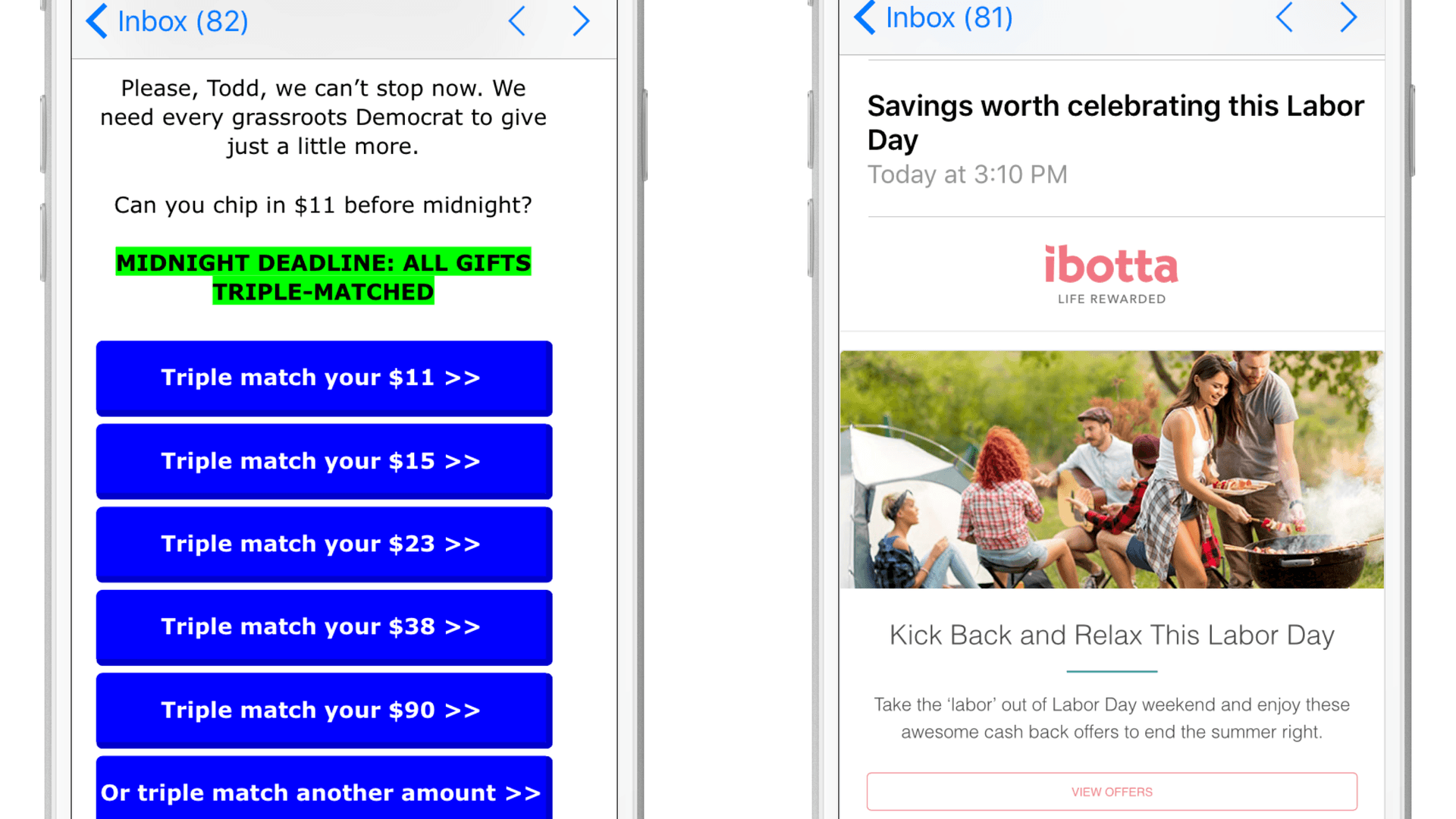
An email from the DCCC (left) and from an email-savvy brand (right)
Let’s be blunt: these messages aren’t email copy at its best. They’re built around scare tactics, and the content of the messages tends to be thin and unengaging at best. The use of images and emojis are haphazard and give the emails a cheap, unappealing vibe. Even worse? They keep using the same unappealing subject lines and copy over and over:
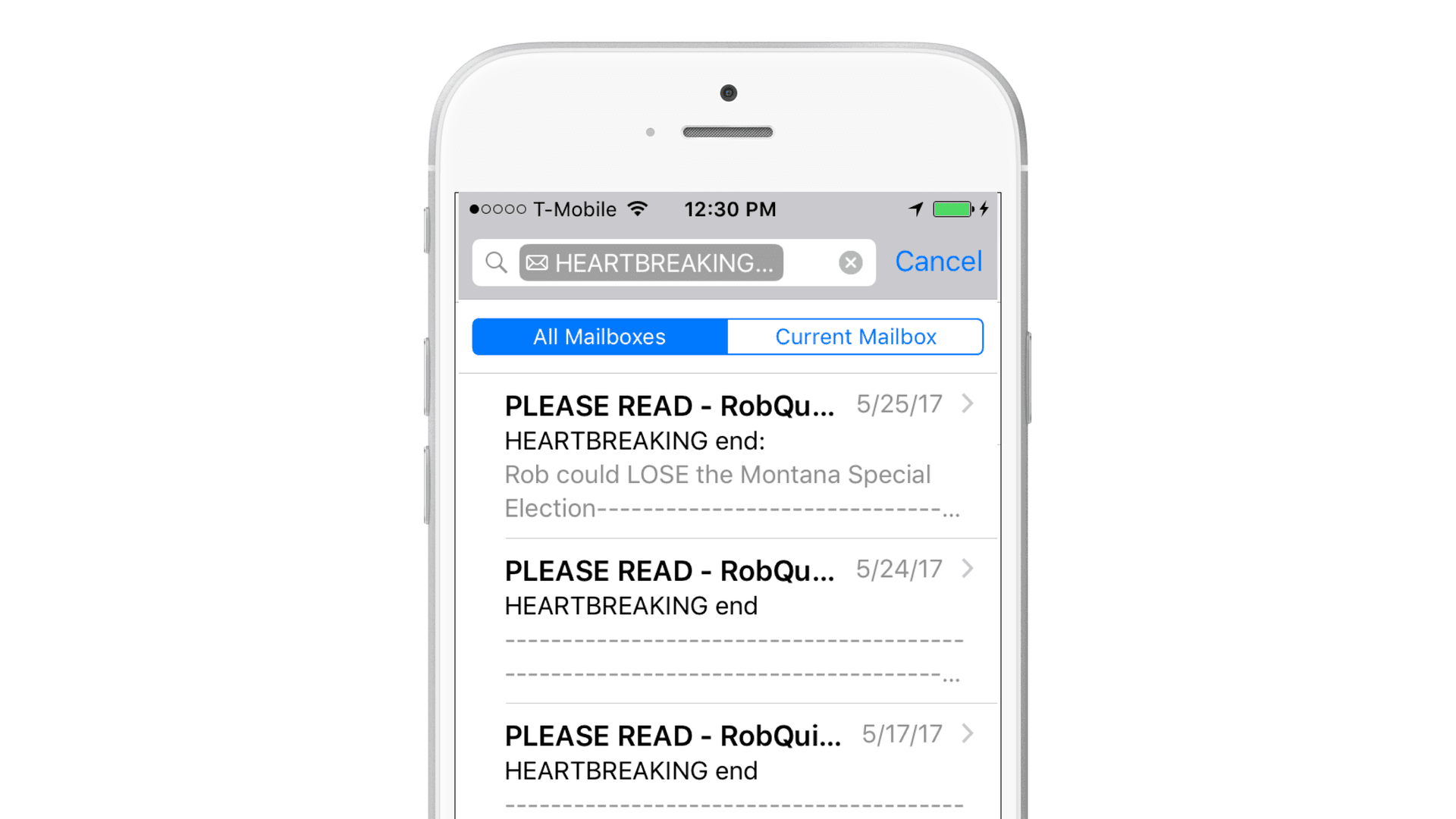
Creating messages that keep your audience interested and engaged isn’t easy, and it’s even harder when you send the same kind of outreach over and over. But with a little thought and care (and the right marketing tools), it’s possible to keep things fresh over the long haul.
5. Sending every message to their entire email list
This is a sin that a lot of companies are guilty of, too. You have a massive email list at your disposal, you’ve got a email that you think is going to perform well—why WOULDN’T you want to send it to everybody? Well, because one size very rarely fits all.
The Ossoff campaign sent a lot of emails asking for money. But while lots of people were unhappy about the outreach, some of the unhappiest were people who experience a barrage of them immediately after making a donation or setting up a recurring payment to the campaign. These people did exactly what the campaign had asked them to do, and what did they get for their troubles? Even more annoying messages begging for cash.
Avoiding this kind of situation isn’t hard. If the Ossoff campaign had segmented their audience based on whether they’d made a donation or recurring payment, they could have exempted recent donors from their outreach, focusing their efforts on people who had yet to donate. Plus, this kind of segmentation would have made it possible to carefully target future messages based on each recipient’s donation patterns, potentially allowing them to turn one-time donors into recurring ones using personalized, targeted outreach. This kind of approach tends to pay off: smart message segmentation by brands has been shown to increase related conversions by 200%.
Final thoughts
If you’re trying to improve your brand’s approach to email marketing campaigns, taking a hard look at the DCCC’s email strategy and doing the exact opposite is a good first step. But you shouldn’t stop there.
The rise of mobile has transformed what’s possible when it comes to email engagement, but only brands with the right tools and tactics are going to be able to take full advantage of this big, new opportunity. Make sure you know the lay of the land when it comes to modern email marketing campaigns and how to make the most of this channel.
Related Tags
Be Absolutely Engaging.™
Sign up for regular updates from Braze.
Related Content
View the Blog
How AI Decisioning Transforms Marketing (A Complete Guide)

Team Braze

AI decisioning cheat sheet: How to crawl/walk/run with BrazeAI Decisioning Studioᵀᴹ

Team Braze

A day in the life of a data scientist on the BrazeAIᵀᴹ forward-deployed engineering team
